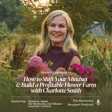
Ep.26: Stonehouse Dahlias: Industry Leaders in Growing Virus-Free Dahlia Cuttings
Have you ever wondered how a simple backyard gardening hobby could blossom into a thriving family-run business supplying high-quality rooted dahlia cuttings to flower farmers and gardeners across the country? In this captivating episode of the Backyard Bouquet Podcast, we delve into the inspiring journey of Julie and Ryan Williams, the passionate duo behind Stonehouse Dahlias in Northern Utah.
Julie and Ryan share their heartwarming tale of transitioning from teachers to dahlia propagators, recounting the pivotal moment when they were approached to sell Kristine Albrecht's renowned K.A. Dahlia varieties through cuttings. The Williams' dedication to producing virus-free plants through tissue culture and their commitment to quality shine through as they discuss the challenges and triumphs of their business.
Tune in to hear expert advice on caring for dahlia cuttings, including the importance of timely planting, providing ample light, and amending soil for optimal tuber growth. The Williams' innovative approach to dahlia propagation, their resilience in the face of setbacks, and their ongoing experimentation with tuber growth methods make Stonehouse Dahlias a beacon of excellence in the dahlia community.
Whether you're a seasoned flower farmer or a budding gardener, this episode is sure to inspire and educate, offering valuable insights into the art of growing vibrant and healthy dahlias.
In This Episode You’ll Hear About:
- 00:00:55-00:01:07: Introduction to Stonehouse Dahlias
- 00:02:23-00:02:33: Story of How Stonehouse Dahlias Got Started
- 00:04:22-00:04:33: Transition to Cuttings
- 00:09:27-00:09:38: Challenges and Growth
- 00:10:30-00:10:40: Collaboration with Kristine Albrecht
- 00:19:47-00:19:58: Growing Virus-Free Stock and Tissue Culture
- 00:22:51-00:23:03: Virus Elimination Process
- 00:26:32-00:26:42: Learning Resilience and Adaptation
- 00:36:13-00:36:25: Controlling Pests in the Greenhouse
- 00:41:55-00:42:05: Tips for Handling Cuttings
- 00:46:34-00:46:46: Getting Tubers from Cuttings
Learn More About Stonehouse Dahlias:
- Website: https://stonehousedahlias.com/
- Instagram: https://www.instagram.com/stonehousedahlias/
***Rate, Review, & Follow The Backyard Bouquet***
If you enjoyed this episode, will you please consider leaving the podcast a review? Your review helps make the podcast more discoverable to others and allows me to continue creating more episodes. I'd love to know what you enjoyed most about the episode.
New episodes every Tuesday to help keep your garden blooming!
Sign up for newsletter: https://thefloweringfarmhouse.myflodesk.com/nlw4wua8s3



















